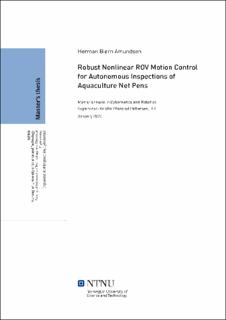| dc.contributor.advisor | Pettersen, Kristin Ytterstad | |
| dc.contributor.advisor | Caharija, Walter | |
| dc.contributor.author | Amundsen, Herman Biørn | |
| dc.date.accessioned | 2020-06-04T16:02:34Z | |
| dc.date.available | 2020-06-04T16:02:34Z | |
| dc.date.issued | 2020 | |
| dc.identifier.uri | https://hdl.handle.net/11250/2656719 | |
| dc.description.abstract | Denne oppgaven presenterer en metode for a kontrollere en fjernstyrt undervannsbåt (ROV) til å autonomt traversere og inspisere en not for bruk i fiskeoppdrett. Metoden er basert på Doppler velocity log- (DVL) målinger, og bruker disse målingene til å estimere ROVens posisjon og orientering relativt til nota. Reiseavstanden til de 4 hydroakustiske DVL-strålene er målt, og fra disse fire målingene så er notoverflaten approksimert som et plan. ROVens pekeretning og avstand til den approksimerte notoverflaten blir videre brukt i en guidingslov.
Den foreslåtte ulineære guidningsloven er basert på siktlinje-banefølging (LOS), og bruker at ROVen er full-aktuert i det horisontale planet til å styre ROVen mot den ønskede banen uavhengig av ROVens pekeretning. Gjennom Lyapunov-analyse så blir det vist at ROVens distanse til referansebanen konvergerer mot null. For å regulere tilstandene til ROVen, så foreslås både en 1. ordens sliding mode-regulator og en super-twisting algoritme med adaptive pådrag, og gjennom simuleringer er responsen til de foreslåtte regulatorene sammenlignet med klassisk PID-regulatorer.
Systemet har blitt designet og tested via simuleringsplattformen FhSim, utviklet av SINTEF Ocean. ROVen presterer bra under simuleringer, og er i stand til å presist følge nota under påvirkning av både bølger og havstrøm. Videre har det blitt gjennomført praktiske eksperimenterer både i basseng, samt på SINTEF ACE, et fullskala fiskeoppdrettslaboratorium. Eksperimentene viser at ROVen er i stand til å autonomt følge nota. | |
| dc.description.abstract | This thesis presents a method for controlling a remotely operated vehicle (ROV) to autonomously traverse and inspect an aquaculture net pen. The method is based on the measurements from a Doppler velocity log (DVL), and uses these measurements to estimate the ROV attitude and position relative to the net pen. The traveled distance of the 4 hydro-acoustic DVL beams is measured, and from these four measurements, the net pen surface is approximated as a plane. The ROV heading and distance relative to the approximated net pen surface are used as inputs in a guidance law.
The proposed nonlinear guidance law is based upon the nonlinear line-of-sight (LOS) guidance law, and utilizes that the ROV is fully actuated in the north-east plane to guide the ROV to the desired path independent of the vehicle heading. Through Lyapunov analysis, the asymptotic convergence of the crosstrack error is proven. Finally, for control of the vehicle states the thesis proposes both a 1st order sliding mode control law and a super-twisting algorithm with adaptive gains, and through simulations the performance of the control laws are compared to that of classical PID control.
The system have been designed and tested using the simulation platform FhSim, provided by SINTEF Ocean. In simulations, the ROV performs well, and is able to accurately traverse the net pen in the presence of both currents and waves. Furthermore, practical experiments using an Argus Mini ROV have been conducted both at a water basin and at SINTEF ACE, a full scale aquaculture laboratory. The results from the experiments verifies the performance of the presented method, and the ROV traverses the net pen successfully. | |
| dc.language | nob | |
| dc.publisher | NTNU | |
| dc.title | Robust Nonlinear ROV Motion Control for Autonomous Inspections of Aquaculture Net Pens | |
| dc.type | Master thesis | |
